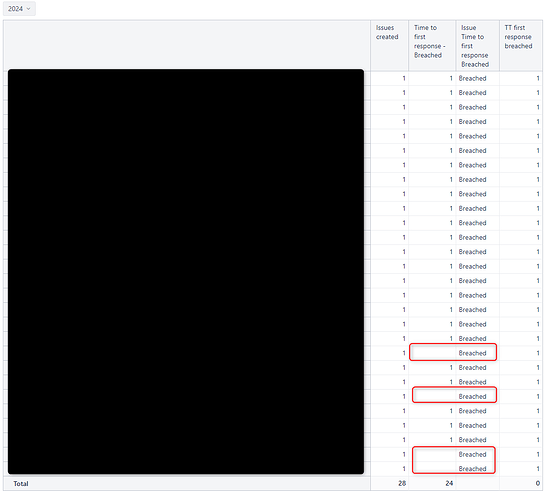Good day,
I have a number of Jira Service Management issues with some SLAs configured. I am trying to set up a report based on respective SLA breach statuses.
Apparently, there are multiple fields for each SLA available. Specifically, I work with an SLA termed “Time to first response”.
- Under Measures > Issue properties, there is a measure “Issue Time to first response Breached”, which contains a string value “Breached” or “Not breached”, respectively.
- Further, there is another measure under Measures > Service Management - Time to first response, “Time to first response - Breached”, which expresses a “1” if that is the case and is empty otherwise.
Now I have discovered, that if the time dimension is set to “All times”, everything is as expected. However, when I restrict the time dimension e.g. to the current year, the value of the numerical value “Time to first response - Breached” is not always “1”, although the verbal measure says “Breached”.
I am confused. Is there an explanation for this or is this a bug?
Thanks, Reinhard
PS: Meanwhile, I added a screenshot illustrating the problem. The additional measure “TT first response breached” is a custom measure translating “Breached” to “1” and serves me as a workaround.
Hi @reinhard.mayr,
While the issue properties are absolute, the measures relate to the context of the report.
I presume that you have applied some time dimension filter on the report, and you are displaying a period that has already ended.
The issues towards the end of the list were created within that period but breached the SLA after the selected period.
Therefore, their absolute property is still Breached, but there were no breached SLA cycles within the filtered period for the selected issues.
This is the intended functionality. You might read more about measures and properties here - Main concepts.
When you need just the absolute category - you can reach for the issue property.
When you need to consider the context - you can reach for measures and their relation to the context.
Regards,
Oskars / support@eazyBI.com
Hi @oskars.laganovskis ,
thank you for your response – it took a while until I have found the time to work it through.
As you can see in the screenshot, I did apply a time period, specifically 2024. In other words, the period is still ongoing, and therefore I am afraid I cannot follow your explanation.
Could you please clearify again?
Thank you!
Hi @reinhard.mayr,
Since you are not sharing the full context of the report - I can only guess for the actual reason.
Please export the report definition and contact the eazyBI support directly over e-mail to get a more detailed explanation.
Please read here about exporting the report definition - Export and import report definitions.
Regards,
Oskars / support@eazyBI.com
